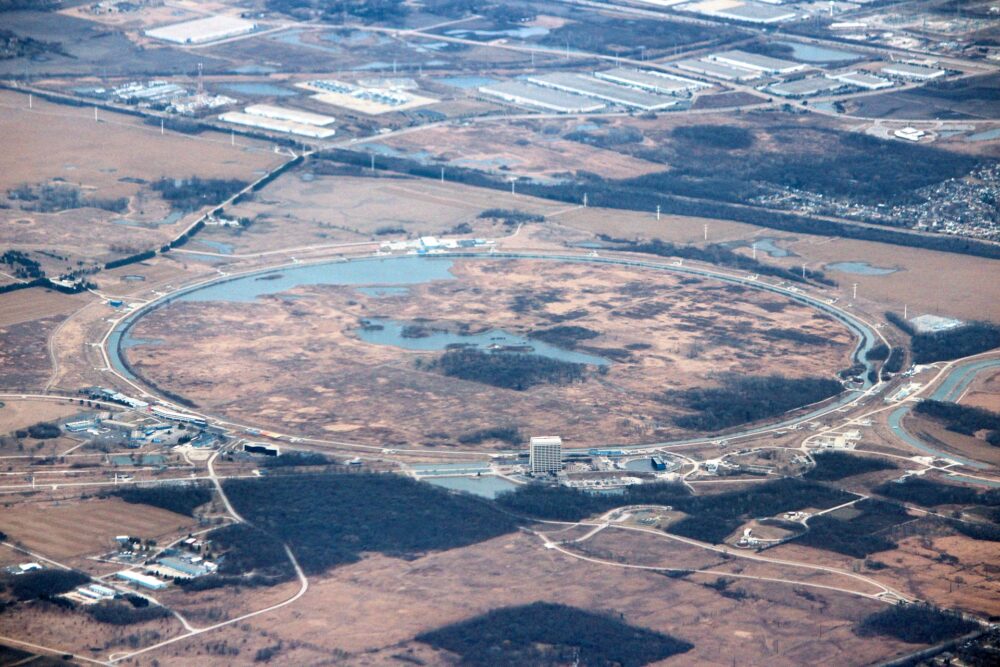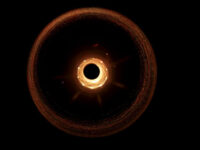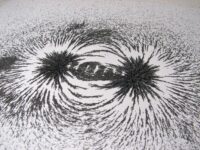Just before midnight in late July 2013, onlookers began lining the side of an interstate right outside of Chicago — many pulling out their smartphones to film. They watched as the flashing police lights leading the procession silently illuminated the suburb. The sea of reds and blues slowly faded into a sweeping gold. Following the police, a truck brandishing an “OVERSIZED LOAD” sign glided forward. “I was awestruck. I’ve seen big things move, but never anything this large,” said a spectator. The truck carried a 50-foot-wide ring covered in white protective material. With bright work lights attached to its underside, the mysterious object resembled an alien saucer straight out of a science fiction film. Its only identifying feature was a banner proudly displayed on its side, reading, “Fermilab: Driving Discovery in Particle Physics.”
As a key component of one of the now-famous muon anomaly experiments, the ring is responsible for storing fundamental muon particles and measuring one of their intrinsic properties: their “spin” — named after the magnetic field it creates and its similarity to that of a spinning electrical charge. Originally from the Brookhaven National Laboratory (BNL) in New York, the storage ring produced an odd result: The muon spin value it measured differed from the expected theoretical value. However, the particle accelerators at BNL did not have the power to produce a result with enough confidence for physicists to label it as a new scientific discovery, which requires the result to have an under one in three million odds that statistical and systematic uncertainty caused the discrepancy. But Fermilab has such an accelerator. So Fermilab shipped the multi-million-dollar experiment down the east coast, around Florida, up the Mississippi River, and finally through the Chicago suburbs to their Batavia campus. There, the team at Fermilab mated the ring to their accelerator, which is second only to CERN’s Large Hadron Collider (LHC) in power.
Built from 1998 to 2008, the LHC had been colliding particles for years by the time Fermilab’s muon spin anomaly experiment began. One experiment on the 16-mile-long accelerator ring of the collider, the LHC beauty collaboration (LHCb), measured yet another troubling muon divergence from theoretical predictions. It would set both CERN and Fermilab’s experiments on a collision course with each other, destined to meet in 2021. The combination of their discoveries would deliver the first blow to one of physics’ flagship theories: The Standard Model of Particle Physics.
The combination of their discoveries would deliver the first blow to one of physics’ flagship theories: The Standard Model of Particle Physics.
Responsible for numerous significant, correct predictions in particle physics, the Standard Model tells a story of the fundamental particles of the universe, their personalities, and their relationships to one another. The basic structure of the Standard Model is a “family,” with two quarks and two leptons. Quarks are ruled by the strongest of the fundamental forces, restraining them from ever separating from one another and existing independently. Leptons, under the control of a fundamental force thousands of times weaker, are much more agile and free to move around. Three “generations” of families make up the Standard Model, and they increase in energy moving from the first generation to the third. Since higher energy particles tend to decay into lower energy relatives, the first generation is the only stable family and is consequently home to the building blocks of matter as we know it. This generation’s quarks make up the protons and neutrons of our atoms — and its charged lepton, the electron, speeds around, facilitating the interactions of these atoms.
While not a fundamental axiom of the Standard Model, a natural consequence of the generational structure — and the foundation for many further calculations — is a property called “lepton universality.” It simply states that the properties of the second generation’s charged lepton, the muon, should mirror those of the electron. While the muon is 200 times heavier, it should interact with particles identically to how an electron does. If a certain particle decay creates a lepton in the process, the decay should have the same probability of creating a muon as an electron. For decades, it seemed like lepton universality held, validating the Standard Model. But then, while studying one type of particle decay, physicists seemed to measure muons disobeying lepton universality by appearing less frequently than electrons in the decay’s resulting particles. Stirring intense debate within the particle physics community, CERN’s LHCb collaboration stepped in.
With the most powerful accelerator in the world and consistent long-term operation, only CERN’s LHC had the data to settle this debate. Sifting through the LHCb’s six years of data to find these decays, which occur roughly once every 2 million collisions, was no easy task, and validating that the methods used to eliminate irrelevant decays were not unfairly biasing either electrons or muons was even harder. To prove the significance of its results, the team first applied its sifting methods to a similar but unrelated decay that had already been independently verified to obey lepton universality. With LHCb’s results from this decay in agreement, they applied the method to the troublesome decay.
While [the Standard Model] has been a powerhouse of prediction and insight — and will continue to be long after potentially amended to a more complete theory — it fails to explain a lot of important physics, including dark matter and dark energy and the Universe’s matter and antimatter imbalance.
In March of 2021, only weeks before the results from Fermilab’s muon experiment were published, LHCb reported the decay disfavored muons by 15 percent — with only a 1 in 1,000 chance that the difference was due to uncertainty in the measurement. Far more precise than any previous measurement, it held enough certainty to classify the results as evidence against lepton universality. However, for the time being, it falls short of the 1 in 3 million mark to claim a discovery.
Fermilab hopes to pass this threshold in its muon experiment. In quantum theory, a simple equation predicts particles’ magnetic fields from their spin and charge; however, in reality, the value comes in over two times larger, and the Standard Model predicts this. Space is not truly empty — it is filled with “virtual particles” that pop in and out of existence, creating a constantly fluctuating mosaic of the colors and flavors of all the Standard Model’s particles. These virtual particles interact with real particles, creating a stronger magnetic field. Theorists can calculate this increase by summing up the effects of every known type of particle; however, for the muon, BNL experimentalists have measured its value to be even larger than the Standard Model prediction. Fermilab hopes to settle this tension.
The storage ring, transported through the Chicago suburbs by Fermilab, creates a strong magnetic field that can capture muons. It sends them speeding around the circle at nearly the speed of light, holding them just long enough to measure their spin. Fermilab has completed three almost year-long runs of the experiment. After analyzing just the first run, the results were clear: They found the same discrepancy BNL had found over a decade prior. They announced this result in April with a confidence of only 1 in 40,000 chance the anomaly was caused by measurement uncertainty. With a much longer fourth run underway, Fermilab aims to inch towards the 1 in 3 million number, hoping to author the momentous first scientific discovery in direct disagreement with the Standard Model.
Physicists hope cracking open the Standard Model with the muon’s misbehavior and consequent breaking of lepton universality will provide the first clues for the future of particle physics.
Over Zoom shortly before going public, Fermilab principal investigators revealed the results to their team, who had been kept in the dark during the analysis process to prevent bias. The results were met with digitalized cheers and a fluorescent grid of overjoyed faces. Breaking the Standard Model is exciting for physicists. While it has been a powerhouse of prediction and insight — and will continue to be long after potentially amended to a more complete theory — it fails to explain a lot of important physics, including dark matter and dark energy and the Universe’s matter and antimatter imbalance. Physicists hope cracking open the Standard Model with the muon’s misbehavior and consequent breaking of lepton universality will provide the first clues for the future of particle physics. One popular possibility is the existence of exotic particles not yet detected, hiding in the sea of virtual particles and pulling strings to manipulate decays and particle properties.
On the future of the muon Standard Model anomalies, Fermilab’s Chief Research Officer Kevin Pitts said, “When I think about our global high energy physics program, we’re trying to look at all of these questions from many different angles. The whole idea is to try and get this comprehensive picture and see how all of these puzzle pieces fit together.” While discovering new physics is still a long way off, the independent results from CERN and Fermilab leave a clear message: The Standard Model has its first crack.
Nature Physics (2021). arXiv: 2103.11769
Physical Review Letters (2021). DOI: 10.1103/PhysRevLett.126.141801




